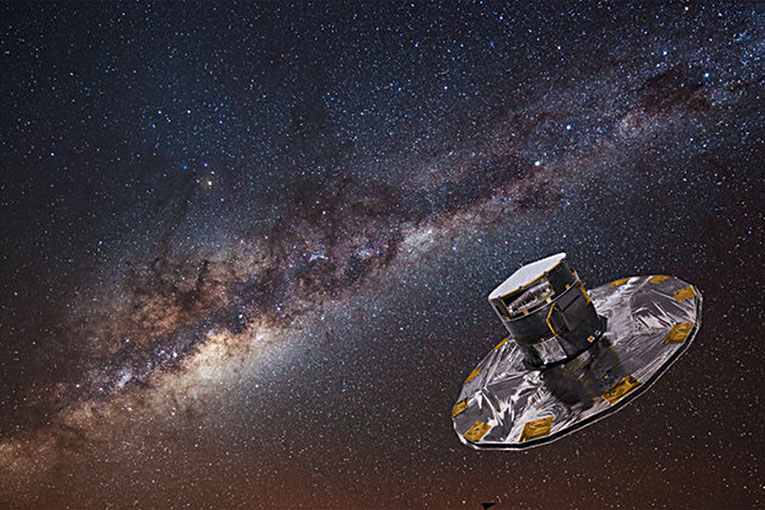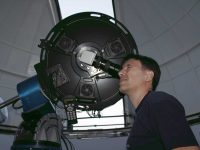
On a cloudless and moonless quiet night and, above all, away from the city’s light pollution, the beauty of the sky fascinates us. This is why, ever since ancient times, humans thought that this must be the work of the gods and so associated constellations with myths.
The whitish band across the sky must have a mythical origin, they thought. Zeus had slept with the mortal Alcmene while her husband Amphitryon was away. Heracles (aka Hercules) was the fruit of this infidelity, becoming Zeus’ favourite son despite Hera, his wife. But Hercules could completely become immortal if he got breastfed by the goddess. Thus, Hermes, commissioned by Zeus, let Hercules beside her while Hera was sleeping. Hera woke up startled and saw him suckling, so, she violently pushed him away. However, some milk leak spread out from Mount Olympus across the sky. This is how, according to myth, the Milky Way came to be, which has fascinated and intrigued both poets and astronomers over the centuries.
«The research about the Milky Way made little progress until a reliable method for estimating distances was found. The discovery of the period-luminosity relation in Cepheid stars allowed to finally knowing the depth of the galaxy»
A thorough observation of the Milky Way reveals bright areas, decomposable into stars, which alternate with dark areas that are nebulae of gas and dust, like the Coalsack Nebula. In places with no light pollution we can also distinguish star clusters with the naked eye, while from the southern hemisphere we can point out two bright nebulae separated from the Milky Way: The Small and Large Magellanic Clouds.
Galileo Galilei first observed the Milky Way with a telescope in late 1609 and early 1610. He saw how the white background was resolved into thousands of stars. But it was in the eighteenth century when Immanuel Kant and Thomas Wright claimed that the Milky Way was actually a disk of stars, where the solar system was just one component. William Herschel in 1780 and Jacobus C. Kapteyn in 1922 made the first maps of the galaxy after counting the stars in many regions of the sky.
The research about the Milky Way made little progress until a reliable method for estimating distances was found. The discovery of the period-luminosity relation in Cepheid stars, achieved by Henrietta Swan Leavitt of the Harvard College Observatory in 1912, allowed to finally knowing the depth of the galaxy. The astronomer found in the Small Magellan Cloud a correlation between the period of brightness variation of these stars and their intrinsic luminosity. The light from the Cepheid variables fluctuates as longer periods are brighter. If we know how much a Cepheid seen from Earth shines and we also know its actual brightness from this period, we are able to calculate the distance.
However, a big question remained unanswered: Is the Milky Way the whole universe or just a galaxy inside a larger group of galaxies? Harlow Shapley, who had placed the Sun at the outskirts of the galaxy after observing many Cepheids across the sky, had thought about only one big galaxy, while Heber Curtis argued that the Milky Way was one of many. In 1920, a big public debate was held to discuss the two stances. Shortly afterwards, Edwin Hubble observed Cepheids in the Andromeda nebula and calculated a distance. Andromeda was so large it had to be concluded that many of the visible nebulae were other very distant galaxies.

The Milky Way from Pinar de Araceli, in Puebla de Don Fabrique (Granada). Jupiter can be seen on the left. / Joan Manel Bullón
Spiral structure
From Earth, the Milky Way is perceived flat and long due to its disc shape. In fact, its shape is quite similar to other galaxies and that has been possible to know due to the infrared data from the COBE satellite, as well as radio observations, for example. Our star is quite secluded, about 26,000 light years away from the galactic centre.
The galactic disk is very thick as it is 100,000 light year long across and only 1,000 in thickness. It is mainly composed of hydrogen gas, dust and young stars, and it is structured as a set of four spiral arms in the form of a perfect logarithmic spiral that are around the galactic centre. There, the gas and powder densities are higher than average, which favours star formation. However, evidence that there are only two arms has recently been found.
In 1996 it was suggested that the central galactic structure wherein the arms are articulated is not spherical, as previously thought, but it is bar-shaped, as seen in other galaxies. In 2005, these suspicions were confirmed thanks to infrared observations with the Spitzer Space Telescope.
According to the most accepted theory, it seems that spiral arms are an illusion and do not represent any mobile structure. If they did, since the rotational speed of the galaxy is differential, which means it is higher near the centre and progressively lower in the outer regions, its arms would bend and wrap after a few rotations until they disappeared. However, that cannot be observed. Modern theories see these arms as density waves. All the galactic disk material rotates, but it slows down and concentrates in some areas just as cars move fast and slow in traffic. In this disk, the Sun crosses the arms and moves in an elliptical orbit that lasts about 240 million years, with disturbances caused by changing mass distributions. This has led to speculation about its influence on climate changes on Earth and mass extinctions of species.
«It seems that spiral arms are an illusion and do not represent any mobile structure. If they did, since the rotational speed of the galaxy is differential, its arms would bend and wrap after a few rotations until they disappeared»
At the end of 2013, ESA’s mission Nesga will be released to survey about billion stars in our galaxy, 1% of the total, and to pinpoint their size, position, distance and displacement with precision. After five years of mission we will surely have a new and more accurate perspective of the disk.
In opposition to the disk, the galactic centre or bulb has a spheroidal structure of about 10,000 light years long across. It is an area rich in stars with different ages, from young stars 200 million years old to old stars more than 7,000 million years old.

Diagram of the Milky Way.
A hole at the centre of the galaxy
The centre of the galaxy is very difficult to study due to the position of the Sun in it. The Sun is located in the direction of the Sagittarius constellation, where we can find dark nebulae which absorb the light from the starts behind which hinders our studying them with conventional techniques. The galactic centre is meant to be observed from ground-based telescopes, from the Spitzer Space Telescope in infrared radiation mode and also through radio telescopes. It is possible to go through these layers of dust and gas and reveal the object located at the centre with infrared, microwave and radio frequencies, and also with X-rays and gamma rays. In 1974, Bruce Balick and Robert Brown discovered an intense radio source called Sagittarius A*, with a totally unknown nature. The density of stars in the galactic nucleus is really high and the stars seem to behave like an isothermal gas. Rainer Schödel, Reinhard Genzel and other colleagues have studied systematically and thoroughly the movement of the stars located within a very short distance (thousands of astronomical units1)
from the centre. Particularly, they described the S2 star with an orbital period of 15.2 years and a minimum distance in the galactic centre of only 120 AU. That means only 17 light hours, a little over three times the major axis of Pluto’s orbit. Such a small orbit with such a short period can only be caused by a very compact body. With these data, the application of Kepler’s third law, whereby if we know the distance to the galactic centre and the period of revolution of the star, the mass of the central body can be directly obtained, we know that the mysterious object in the centre of the galaxy is actually a supermassive black hole of about 4.1 million solar masses. Recent observations suggest that the radius is only 6.25 light hours long, just as Uranus’ orbit.
The existence of a supermassive black hole has been found usual in most, if not all, of the spiral and elliptical galaxies. The explanation of this fact, according to current theories, would be sought in the collapse of supermassive stars or either in the result of the collision between galaxies.
The last luminous component in the galaxy is the halo surrounding the previous structures and it consists of at least 150 globular clusters and field stars with high speed and orbits perpendicular to the galactic plane.
Globular clusters are formed by hundreds of thousands of stars grouped into spherical shape in a volume of a few light years. The best known example is M13, located in the Hercules constellation. Harlow Shapley showed that the distribution of globular clusters is very homogeneous around the galactic centre. Virtually, all of them are located in an area of 137,000 light years from the centre.
The main feature of its stars is the low content of heavy elements or low metallicity, indicating its old age, as they have not been contaminated by previous supernova explosions. We should not be surprised, therefore, that the «youngest» globular clusters are 11,000 million years old, while the oldest, 13,000 million years old, is only slightly younger than the universe itself. These objects are undoubtedly the oldest of the galaxy.

X-ray image obtained by the Chandra satellite of the supermassive black hole Sagittarius A * and the surrounding region. We can observe the remnant of the Sagittarius A* East Supernova and the hot gas lobes that are extended twelve light years on each side of the black hole. / NASA/CXC/MIT/F. Baganoff, R. Shcherbakov et al.
The dark matter mystery
When the masses of all luminous components of the galaxy are added -the gas and dust disk, the stars, the bar, the bulb, the central black hole and the halo-, a total mass of 9×1010 solar masses is reached. This value, which is achieved by very different techniques and observations, correlates well with the value of the mass located inside the orbit of the Sun. If Kepler’s third law applies to the Sun’s orbit around the galactic center, the inner mass is 8.8×1010 solar masses. This coincidence of results is not accidental since most of the luminous mass is within the solar orbit.
Therefore, within the community of astronomers it came as a surprise to note that, beyond the Sun, the speed of the stars did not diminish while distancing from the centre, but remained constant as if something «stretched» the stars. This effect has also been observed in other spiral galaxies, as it was verified by the astronomer Vera Rubin and colleagues in the late seventies. Something unknown and brightless makes the stars on the outskirts of spiral galaxies move faster than what it may seem reasonable. Since this brightless, albeit with mass, component, exerts a gravitational pull on the visible component, is called dark matter and it is a factor to be taken into account in all large-scale simulations of the formation of the universe or in the formation of galaxies.
The dark matter halo appears to be spherically distributed, and it encompasses the stellar halo and extends to 750,000 light years of distance from the galactic centre. Its mass is 1.9×1012 solar masses. This huge mass makes the mass of visible components ridiculous, as this only represents 4.5% of the total mass.
But what is this component? For now, it is a mystery. It cannot be from ordinary matter as gas or interstellar dust, because their presence would have already been detected with conventional techniques. The first convincing hypothesis suggested massive compact objects (MACHO, from Massive Astronomical Compact Halo Objects). This category would include white dwarfs, neutron stars, brown dwarfs and black holes, which are already dead and dull stars or others stars that have failed to shine. The presence of these MACHO can be detected when passing between a distant star and the Earth. Then, the light of the star can be diverted and augmented by a relativistic effect called gravitational lens. C. Alcock and other colleagues have studied millions of stars from the Large Magellanic Cloud and they have found very few examples of these phenomena. Therefore, they conclude that the MACHO’s contribution to the dark matter halo is only 20%.
Currently, it is considered that massive particles that weakly interact (WIMP, which stands for Weakly Interacting Massive Particles) constitute the main part of the dark matter. Some theoretical considerations on the formation and evolution of the universe would support these unknown particles.

Simulated photographs on the right show the sequence of the clash between the Andromeda galaxy and the Milky Way (from top to bottom and left to right): a) Current night sky, with the Milky Way and the Andromeda galaxy 2.5 billion light years away. b) Within 2,000 million years, the disk of Andromeda galaxy, which is approaching, is noticeably larger. c) Within 3,750 million years, Andromeda fills the vision field. d) and e) In 3,850 to 3,900 million years, during the first approach, the sky glows with the formation of new stars. f) Within 4,000 million years, Andromeda is stretched by the tides. The Milky Way is also deformed. Andromeda separates from the Milky Way but then returns. g) Within 5,100 million years, during the second passing, the nucleus of the Milky Way and Andromeda appear as a pair of bright lobes. h) Within 7,000 million years, the merged galaxies constitute a large elliptical galaxy. Clean from dust and gas, the new galaxy no longer has young stars and nebulae.
Fusion with the Andromeda galaxy
The Milky Way and the great Andromeda galaxy, which is located about 2.5 million light years from us, and dozens of smaller galaxies, constitute the Local Group of galaxies that are gravitationally bound to each other and are moved by forces that exert visible mass and dark matter that is between them. So, while the whole universe rapidly expands, the components of the Local Group move together, but can converge internally.
We already know that Andromeda has been approaching the Earth for a hundred years. The latest measurements confirm that its speed is 400,000 kph, as great as it can traverse the distance between the Earth and the Moon in an hour. But despite this enormous speed, Andromeda will not arrive here before 4,000 million years have passed. What was not known until recently is whether the collision between the two galaxies would be frontal -with its consequent catastrophically end- or tangential, with only slight deformations of galactic structures.
Recently, the team led by Roeland van der Marel and other colleagues have resolved this dilemma after studying the movement of individual stars in Andromeda for eight years. In a long process the two galaxies will approach and deform by tidal effects. They will eventually merge and form a single new elliptical galaxy. It seems that individual stars in each galaxy will not be affected, since they are separated by large distances. It would be better to speak of a collation rather than a collision. Of course, their positions will be affected. The Solar System will not be destroyed by the collision, but the Sun and its court of planets including the Earth, will be surely shipped somewhere else of the new elliptical Andromeda-Milky Way galaxy. However, by that time the Earth will be too hot for habitation, heated by an immense Sun becoming a red giant.
Sometimes you know that a situation will end badly, no matter what will happen. But, at least, you can postpone the final outcome or leave it for future generations. And you can selfishly feel satisfied.
1. Each astronomical unit (AU) is the distance between Earth and the Sun. (Go back)
Bibliography
Carroll, B. W., & D. A. Ostlie, 2007. An Introduction to Modern Astrophysics. Pearson International Edition. San Francisco.
Martínez, V. J.; Miralles, J. A.; Marco, E., & D. Galadí-Enriquez, 2008. Astronomia fonamental. PUV. València.




